From the rugged cliffs of the Palisades to the sparkling streams of the Kittatinny Mountains, New Jersey is a true paradise for rock enthusiasts and nature lovers. Our state’s geological diversity is truly astounding, featuring a rich tapestry of formations that date back millions of years.
Whether you’re a seasoned geologist or simply an admirer of natural beauty, you’ll find different captivating types of rocks and minerals in New Jersey. And within our state’s borders lie an abundance of spots where these natural wonders can be uncovered.
But New Jersey’s rocks, minerals, gems, and crystals are not just scientific curiosities— they’re also artistic marvels! With their vibrant colors and intricate patterns, these treasures have captivated human imagination for centuries. In this article, we’ll introduce you to our state’s vast natural wonders. Let’s begin!
A List of The Common Rocks, Stones, and Minerals Found in New Jersey
New Jersey is endowed with an astonishing array of natural treasures that are simply fascinating. Lucky for you, we’ve created several comprehensive guides that you can use to find them. Check these out:
New Jersey Rock, Mineral, and Gem
First, let’s get to know the staples when it comes to our state’s natural treasures.
| New Jersey State Rock | Brownstone |
| New Jersey State Mineral | Franklinite |
| New Jersey State Gem | Prehnite |
To find out more about the geologic policies in our state, go to the New Jersey Department of Environmental Protection (NJDEP) website.
Always Confirm Access and Collection Rules!
Before heading out to any of the locations on our list you need to confirm access requirements and collection rules for both public and private locations.
These requirements are subject to change without notice and may differ from what we state below.
Always get updated information directly from the source ahead of time to ensure responsible rockhounding.
Marble

With its exquisite beauty and versatility, Marble has enchanted civilizations for centuries. It forms from limestone that was subjected to intense heat and pressure deep within the Earth’s crust in a process called, “Metamorphism“.
In New Jersey, one prominent variety of Marble that you can find is the Franklin Marble, which displays stunning hues of white, gray, and pink. It’s famous for its exceptional crystalline structure and is often admired for its use in architectural applications.
Another notable variety is the Cockeysville Marble, which features shades of white, beige, and gray. It’s known for its durability and has been used in the construction of buildings and monuments throughout history.
Truly, Marble is highly valued for its remarkable aesthetic qualities. In fact, each of its piece is one-of-a-kind! If you’re curious to know just how valuable Marble is, checkout our article on that, too.
Where you can find Marble in New Jersey
You can find Marble in the exposures of Turkey Mountain near Lake Valhalla.
Galena

As the primary ore of lead, Galena is known for its distinctive metallic luster and crystal structure that resembles cubes.
The Franklinite-Galena Ore is a notable variety found in the famous Franklin and Sterling Hill mines in our state. It often occurs alongside other minerals like zinc and iron, creating a visually striking combination.
Galena is highly valued for its lead content and its significance as an industrial mineral. Lead has a wide range of applications: from batteries and ammunition to construction materials and radiation shielding. Galena’s density and low melting point make it an ideal source of lead.
Where you can find Galena in New Jersey
There are several locations in our state where you can find Galena, such as:
- Mining dumps along Cork Hill Road in Franklin
- Prospect Park Quarry
- Quarries and area exposures in Union County
Franklinite

Franklinite holds a special place in the geological heritage of our state. In fact, it a senate bill was even passed to make it New Jersey’s official state mineral. Named after the town of Franklin, where it was first discovered, Franklinite is a complex ore mineral known for its dark color and metallic luster.
Franklinite forms when hot mineral-rich fluids interact with rocks deep within the Earth’s crust. Some specimens of this mineral from New Jersey exhibit a deep black color, while others have hints of brown, gray, or even reddish hues.
Franklinite is highly valued for its industrial applications due to its iron and zinc content. Iron is crucial for the production of steel, while zinc has various uses in automotive, construction, and agricultural industries. Its manganese content is also used in the production of alloys, batteries, and fertilizers.
Where you can find Franklinite in New Jersey
You can find Franklinite in the area zinc mines of Franklin, especially along Cork Hill Road. You can also uncover specimens of this mineral at the Sterling Hill Mine.
Datolite
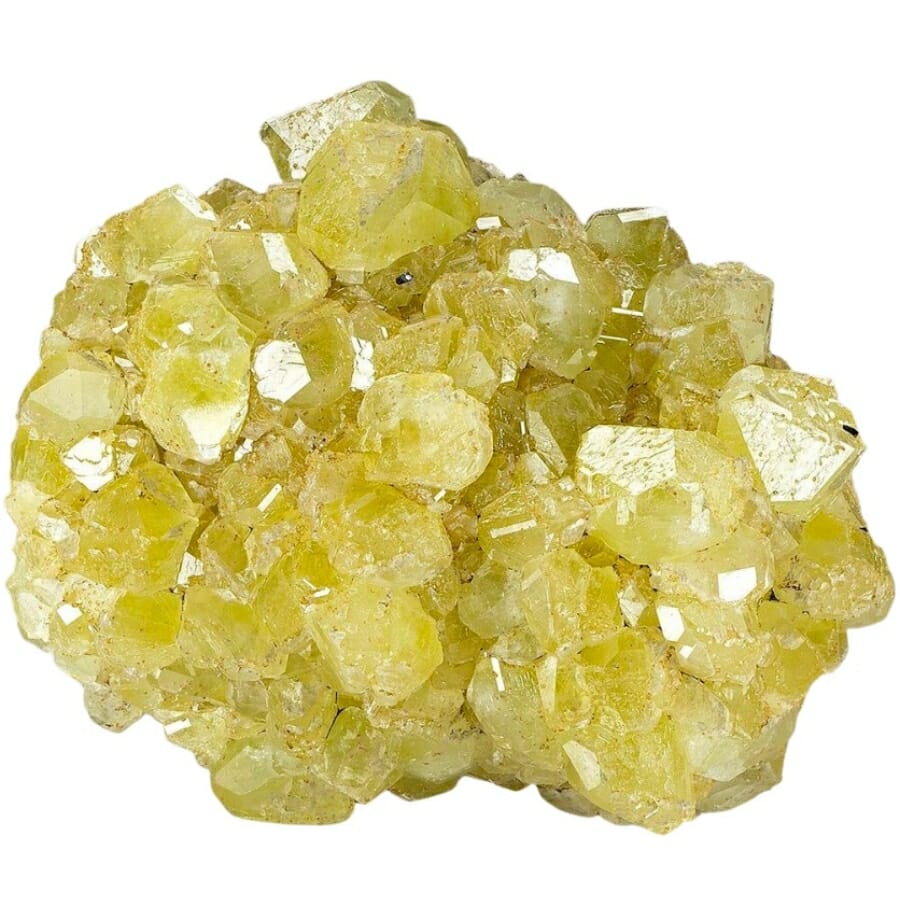
Datolite is a captivating mineral that forms in hydrothermal environments. It’s most notable variety that you can find in New Jersey is the green Datolite. Other color variations include shades of white, yellow, and brown.
This mineral is highly valued for its aesthetic appeal. Its vibrant colors, translucent nature, and well-formed crystal structures make it a sought-after addition to mineral collections. Datolite’s unique beauty and its ability to display different colors and formations contribute to its desirability among collectors.
Moreover, Datolite also holds scientific importance. Studying this mineral helps geologists better understand the hydrothermal history of New Jersey.
Where you can find Datolite in New Jersey
Datolite is well-scattered in our state, so you can find it in plenty spots here, including:
- Basalt and diabase outcrops and road cuts of Bergen County
- Haledon area quarries
- South on Silver Road
Soapstone

Also known as Steatite or Soaprock, Soapstone is primarily composed of talc, a soft mineral that gives it a smooth and soapy texture.
You may stumble upon different types of Soapstone in New Jersey. One variety, called Architectural Soapstone, is highly regarded for its heat resistance and low thermal conductivity. This makes it ideal for use in fireplaces, stoves, and countertops, as it can withstand high temperatures without cracking or warping.
Another type is the Artistic Soapstone, which is valued for its workability. Its softness allows it to be easily carved and shaped, making it a popular choice for sculptures, bowls, and other decorative items.
Where you can find Soapstone in New Jersey
You can explore the area quarries of Phillipsburg to find samples of Soapstone.
Goethite

Goethite is an iron oxide mineral that often occurs in association with other iron minerals, such as Hematite and Limonite. It also exhibits a wide range of colors and formations, captivating the attention of rock enthusiasts and collectors.
The most common variety of Goethite that you’ll find in New Jersey is the Botryoidal Goethite, which forms rounded, grape-like clusters. These formations can display colors ranging from yellow to brown, giving them a striking and eye-catching appearance.
Just like Datolite, Goethite also has scientific contributions. Geologists better understand the history of weathering and mineral deposition in New Jersey by studying this mineral.
Where you can find Goethite in New Jersey
You can find Goethite in the following areas in our state:
- Haledon area quarries
- Pompton Lakes area quarries
The Gemstones Found In New Jersey
Aside from rocks and minerals, New Jersey also has a diverse range of precious and semi-precious gemstones. If you want to know where to find them, better check out our full guides here:
Prehnite

Prehnite is an enchanting gemstone that has captivated the hearts of jewelry enthusiasts and collectors with its soothing green hues and unique crystal formations.
The most notable variety of Prehnite that you can find in New Jersey is the Franklin Prehnite, named after the famous Franklin mining district. This variety is known for its apple-green color and can occur as well-formed crystals or botryoidal aggregates.
Prehnite is highly valued for its aesthetic appeal and metaphysical properties. Its serene green color make it a favored gem for jewelry. It’s also believed to promote inner peace, clarity, and emotional balance. Associated with spiritual growth, it’s said to enhance intuition and connect you with higher realms of consciousness.
Where you can find Prehnite in New Jersey
Prehnite abounds in New Jersey, so you can find it in many areas of our state, such as:
- Somerville area quarries
- Upper Montclair area quarries
- Watchung Mountains
Carnelian
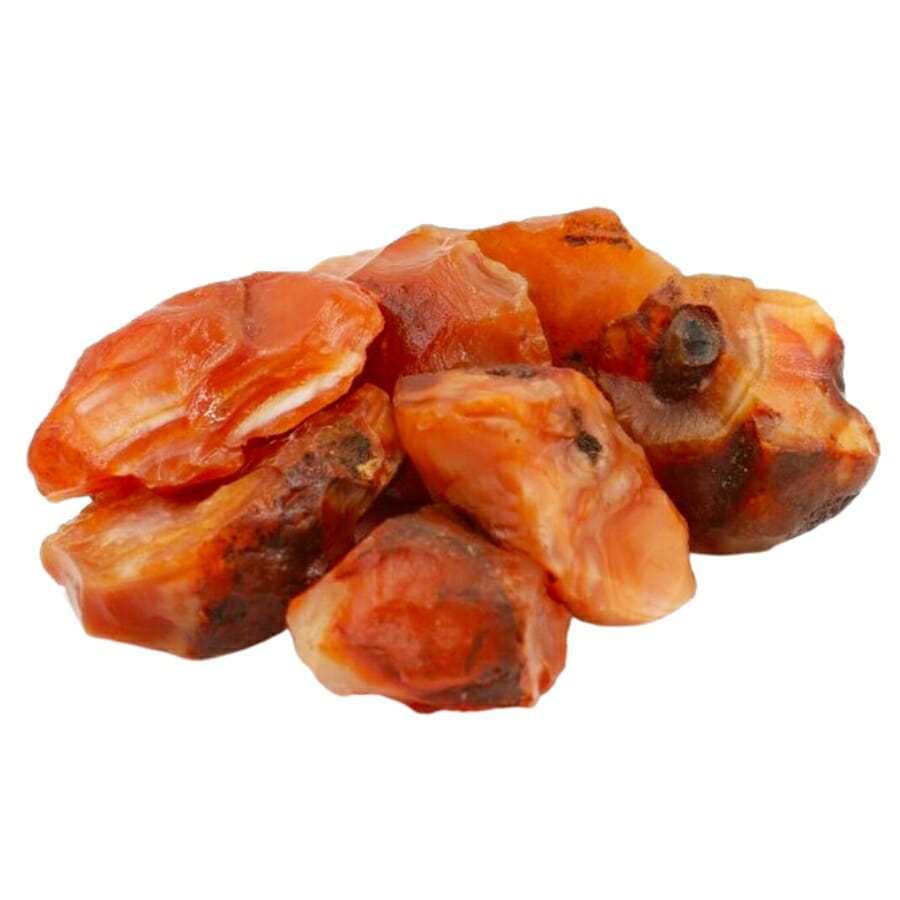
Carnelian has been cherished for centuries for its warm, fiery colors and rich cultural significance. As a variety of Chalcedony, it’s known for its vibrant shades of orange, red, and brown.
In ancient times, it was believed to have protective and healing powers, symbolizing courage and strength. Today, it’s still highly regarded for its energizing and revitalizing properties, believed to enhance motivation, creativity, and self-confidence.
As a gemstone, Carnelian is widely used in jewelry, adding a touch of warmth and vibrancy to designs. Its distinct colors and varied patterns make each specimen unique and highly sought after by collectors and jewelry enthusiasts.
If you’re struggling to tell carnelian apart from similar rocks and minerals, our informative guides are here to save the day:
Where you can find Carnelian in New Jersey
You can find Carnelian if you explore the following spots:
- Stirling Brook
- Creek south of Passaic River
- Basalt and diabase outcrops and road cuts in Bergen County
Opal

Opal is a gemstone that enchants with its play of vibrant colors and captivating iridescence. It’s composed of tiny spheres that diffract light, creating a stunning display of spectral colors.
This gem is highly valued for its extraordinary visual effects and its symbolic meanings. It’s often associated with inspiration, creativity, and love. It’s also regarded as birthstones for October, symbolizing hope and purity. Read more about Opal’s current price in the market here.
Opal is sought after for its unique and ever-changing beauty so much so that it’s considered to be a precious gemstone. Its iridescence and vibrant colors make it a popular choice for jewelry, where it can be showcased in rings, necklaces, and earrings.
Where you can find Opal in New Jersey
Opal can be found in several sites in New Jersey, such as:
- Basalt and diabase outcrops and road cuts in Bergen County
- Basalt exposures in Hoboken
- Dover area
Epidote

Epidote showcases a stunning range of colors and exhibits unique crystal formations. It’s formed when hot fluids rich in calcium and aluminum interact with rocks under high-pressure conditions. As these fluids cool, they deposit Epidote crystals, creating intricate and eye-catching patterns.
Epidote specimens in New Jersey come with different variations in color, transparency, and crystal size. This gem can range in color from vibrant green to yellow, and even shades of brown.
Epidote is highly valued for its aesthetic appeal and its metaphysical properties. Its rich green color and lustrous shine make it a sought-after gemstone for jewelry. Additionally, it’s believed to promote personal growth, balance, and spiritual well-being.
Where you can find Epidote in New Jersey
Epidote is abundantly scattered in different parts of our state, including:
- Bergen Hill by Hudson River
- Cavities and debris in The Palisades
Malachite

Malachite, with its vibrant green color and distinctive banding patterns, forms as a result of chemical reactions between copper-rich solutions and limestone or other carbonate rocks.
This gemstone has been valued for centuries for its striking appearance and symbolic meanings. It associated with healing, protection, and transformation. In jewelry, it’s highly sought after for its unique green hues and the beautiful patterns it displays. Check out our article on Malachite’s value and price for more information.
Beyond its aesthetic appeal, Malachite is also appreciated for its historical and cultural significance. Throughout history, it has been used in decorative arts, such as jewelry, sculptures, and even interior design, adding a touch of natural beauty to various artistic creations.
Where you can find Malachite in New Jersey
You can find Malachite in a handful of areas in our state, particularly:
- Bergen Hill by Hudson River
- Cavities and debris in The Palisades
- Railroad and road cuts from Bayonne to Edgewater
Serpentine

Serpentine is a fascinating gemstone known for its unique green color and smooth texture. It’s formed through a process called “serpentinization“, which occurs deep within the Earth’s mantle.
You can find Serpentine in different variations in New Jersey, including differences in color— ranging from light green to dark green— as well as in texture and mineral composition.
Serpentine is valued for its aesthetic appeal and its cultural significance. Its smooth texture and rich green color make it a popular choice for carving and crafting unique jewelry pieces. It also has scientific importance since its presence can indicate areas of tectonic activity and the presence of mineral deposits.
Where you can find Serpentine in New Jersey
You can find Serpentine in different areas of our state, such as:
- Hoboken area Serpentine outcrops
- Somerville area quarries
- Turkey Mountain near Lake Valhalla
Siderite

Siderite is a captivating gemstone known for its earthy brown colors and unique crystal formations. It forms through various processes in sedimentary environments.
In New Jersey, Siderite comes in different color intensity, crystal shape, and transparency. It can range in color from light brown to deep brown or even reddish-brown. This is also why it’s valued for its aesthetic appeal, with its earthy tones and unique crystal habits often appreciated in collections and jewelry.
Siderite is also believed to possess metaphysical properties, as it’s associated with grounding, stability, and promoting a sense of calmness and balance.
Where you can find Siderite in New Jersey
You can find Siderite in the following spots:
- Cavities and debris in The Palisades
- Railroad and road cuts from Bayonne to Edgewater
- Snake Hill
The Crystals Found In New Jersey
Are you ready to marvel at New Jersey’s very own crystals? Luckily, our state boasts of a variety of stunning crystals. If you’re wondering where exactly you can find them here, check out this guide:
Albite

Albite is a fascinating crystal known for its beautiful white color and striking transparency. Belonging to the Feldspar mineral group, it’s composed of aluminum, silicon, and oxygen.
Like other crystals, Albite in New Jersey come with different unique characteristics. These variations include differences in transparency, crystal size, and the presence of other minerals.
Because of Albite’s pure white color and transparency, it’s become popular for use in jewelry and decorative purposes. It’s also believed to have calming and balancing energies, promoting emotional well-being and harmony.
Where you can find Albite in New Jersey
You can find Albite in a few places in our state, such as:
- Snake Hill
- Sommerville
- Union County area quarries and exposures
Amethyst

Renowned for its stunning purple color and captivating crystal formation is Amethyst, which belongs to the quartz family. It gets its mesmerizing hues from trace amounts of iron impurities within its crystal structure.
It typically occurs in geode cavities within volcanic or metamorphic rocks.
Both crystal and geode Amethyst naturally occur in New Jersey. It’s highly valued for its beauty and metaphysical properties. Its striking purple color has long been associated with royalty and spirituality. It also adds irresistible elegance and charm to any jewelry. Know more about Amethyst’s value by reading our pricing guide.
As for its metaphysical properties, Amethyst is believed to possess calming and protective energies, promoting clarity of mind, emotional balance, and spiritual growth.
Where you can find Amethyst in New Jersey
You can get a glimpse of the captivating sight of Amethyst in the following places:
- Brook gravels in Warren Township
- McBride Avenue abandoned quarry
- Somerset Crushed Stone Quarry
Chalcopyrite

Chalcopyrite is known for its metallic luster and stunning brassy yellow color. It’s formed in hydrothermal veins, which are formed when hot fluids rich in minerals circulate through cracks and fractures in rocks. As these fluids cool and interact with the surrounding rock, Chalcopyrite crystals grow.
As in other places, Chalcopyrite in New Jersey comes with variations in color, crystal size, and the presence of other minerals. It’s highly valued for its unique appearance and its economic significance. It is a major copper ore and serves as a primary source for the extraction of copper, which is widely used in various industries.
Aside from its practical industrial use, Chalcopyrite’s metallic luster and vibrant color make it a popular choice for collectors and jewelry enthusiasts.
Where you can find Chalcopyrite in New Jersey
You can find samples of Chalcopyrite in these areas:
- Middlesex area mines
- Mine Hill area mines
- Mt. Freedom area pits, exposures, and road cuts
Fluorite
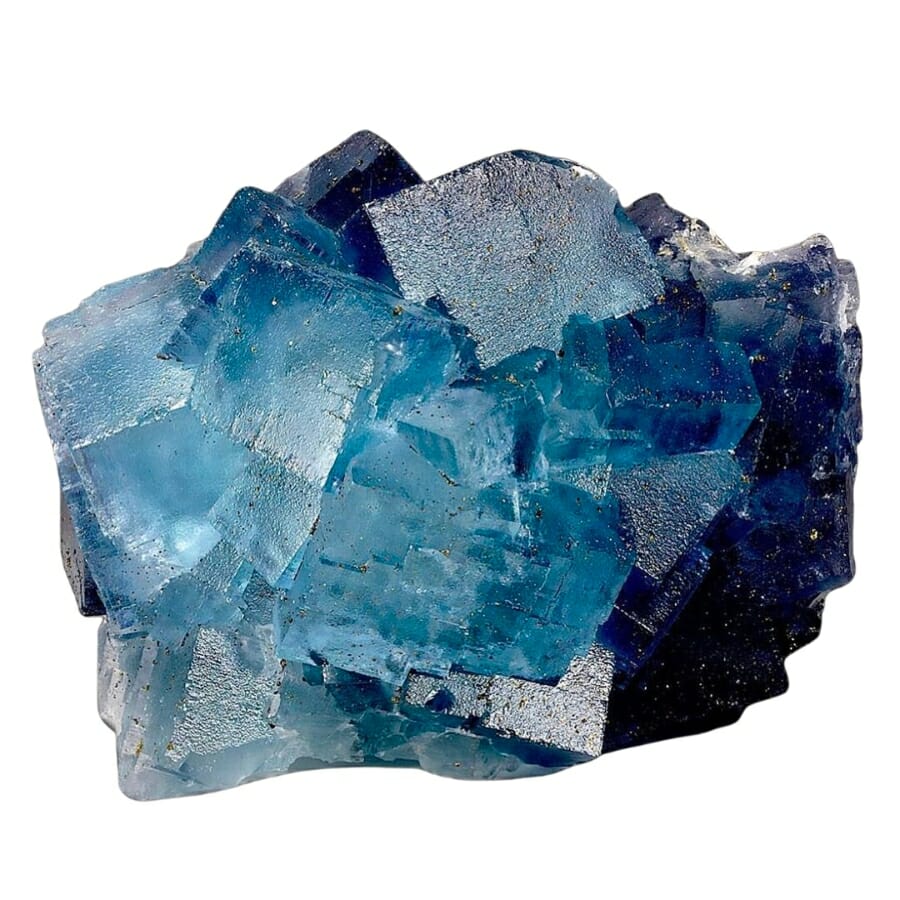
Fluorite is an enchanting crystal renowned for its vibrant range of colors and captivating transparency. The presence of different impurities and elements during its formation gives rise to its diverse colors, including purple, green, blue, yellow, and pink.
In New Jersey, Fluorites come in different hues, color intensity and crystal size.
Fluorite is highly valued for its aesthetic appeal and its metaphysical properties. Its vibrant colors make it a sought-after crystal for collectors and jewelry designers. It’s also believed to promote mental clarity, focus, and spiritual growth. Want to know Fluorite’s current market price? Checkout our article on that.
Where you can find Fluorite in New Jersey
Fluorite is pretty much limited in New Jersey. You can find its sole source in our state at the Franklin Furnace.
Hematite

Hematite is a remarkable crystal known for its metallic luster and deep reddish-brown color. It’s commonly found in sedimentary rocks, but it can also form in hydrothermal veins.
Hematite specimens in New Jersey have different crystal structure, color intensity, and minerals present. Highly valued for its beauty, it’s widely used in jewelry and decorative items. It also has practical uses in the production of steel. Read more about Hematite’s worth and value here.
Beyond its aesthetic and industrial significance, hematite is also believed to possess grounding and protective energies. It’s associated with strength, courage, and enhancing focus and concentration.
Where you can find Hematite in New Jersey
You can uncover Hematite in different nooks and crannies of our state, especially in:
- Mine Hill area mining dumps
- Pompton Lakes area quarries
- Prospect Park Quarry
Pyrite

Fool’s gold, anyone?
Just like Gold, Pyrite has a brassy yellow color and metallic luster. It often develops in association with organic matter and can be found in coal beds, shale, and other sedimentary rocks.
Pyrite’s resemblance to gold has earned it its nickname, but it’s appreciated for more than just its deceptive looks. It’s an important source of sulfur and is used in the production of sulfuric acid, a crucial chemical in many industries. Know more about how much Pyrite is worth here.
Pyrite also has metaphysical properties and is believed to possess protective and grounding energies. It’s associated with promoting prosperity, abundance, and positive energy.
Where you can find Pyrite in New Jersey
Pyrite is quite abundant in our state and you can find them in the following areas here:
- Hibernia area mines
- Mine Hill area mining dumps
- Sayreville area sands, gravels, and streams
The Most Valuable Rocks and Minerals in New Jersey
While we’ve already shared with you the most common natural wonders here, we’ve yet to discuss the most valuable rocks and minerals in New Jersey. Just like beauty, value is in the eye of the beholder, so it’s important to note that while their prices may not be the highest in the market, their value is more than their monetary worth.
Amber

Amber is a captivating gemstone that has been treasured for centuries. It’s actually a fossilized tree resin that has hardened over millions of years. This unique process of preservation gives it its beautiful golden color and stunning clarity.
In New Jersey, you can find different types of Amber, each with its own distinct characteristics. Some contain inclusions of insects or plant material, adding to their scientific and historical value.
Amber is highly valued for its aesthetic appeal and historical significance. Because of the way it was formed, it provides valuable insights into prehistoric ecosystems, making it a valuable resource for scientific research. It’s also believed to possess healing properties, promoting balance, clarity, and positive energy.
Where you can find Amber in New Jersey
Amber abundantly occurs in New Jersey and you can find it by exploring the following areas:
- Bridgeport & Gibbstown area sands and gravels
- Crosswicks Creek
- Jean & Ric Edelman Fossil Park
Pearl

Known for its lustrous appearance and timeless elegance, Pearl is a stunning gem that’s worth noticing. Unlike most gemstones, it’s not formed within the Earth but is produced by living organisms known as mollusks, such as oysters and mussels.
The formation of a pearl begins when an irritant, such as a grain of sand or a parasite, enters the soft tissue of a mollusk. In response, the mollusk secretes layers of a substance called nacre, also known as mother-of-pearl, around the irritant. Over time, these layers build up and form a beautiful, iridescent pearl.
Pearls are highly valued (checkout Pearl’s prices here) for their natural beauty and rarity. Their iridescent luster and delicate colors make them a popular choice for jewelry. They also have cultural and historical significance in many societies and are often associated with wealth, femininity, and timeless style.
Where you can find Pearl in New Jersey
You can find Pearls in the following places in our state:
- Morris Countywide in lakes and streams
- Passaic Countywide in lakes and streams
- Sussex Countywide in lakes and streams
Sunstone

Sunstone is a dazzling gem that exhibits a unique play of light, resembling the warm hues of the sun. It’s a variety of Feldspar that gets its captivating optical effects from the presence of tiny Copper or Hematite inclusions.
The formation of Sunstone begins deep within the Earth’s crust, where molten rock, or magma, slowly cools and solidifies. During this cooling process, Copper or Hematite separate from the Feldspar, forming inclusions that create its characteristic shimmer and sparkle.
Sunstone is often used in jewelry and decorative pieces to add a touch of warmth and vibrancy. It’s also believed to have metaphysical properties, such as promoting positive energy, creativity, and vitality.
Where you can find Sunstone in New Jersey
You can find Sunstone in Mine Hill, specifically near its summit, in its area mining dumps, and in the Alan Wood Iron Mine.
How to Identify The Rocks and Minerals You Find
While it’s exciting to identify rocks and minerals, it’s also a challenging task that requires careful observation and knowledge. In this section, we’ll share with you the different ways that you can try to successfully identify your specimen.
Closely observe the rock or mineral
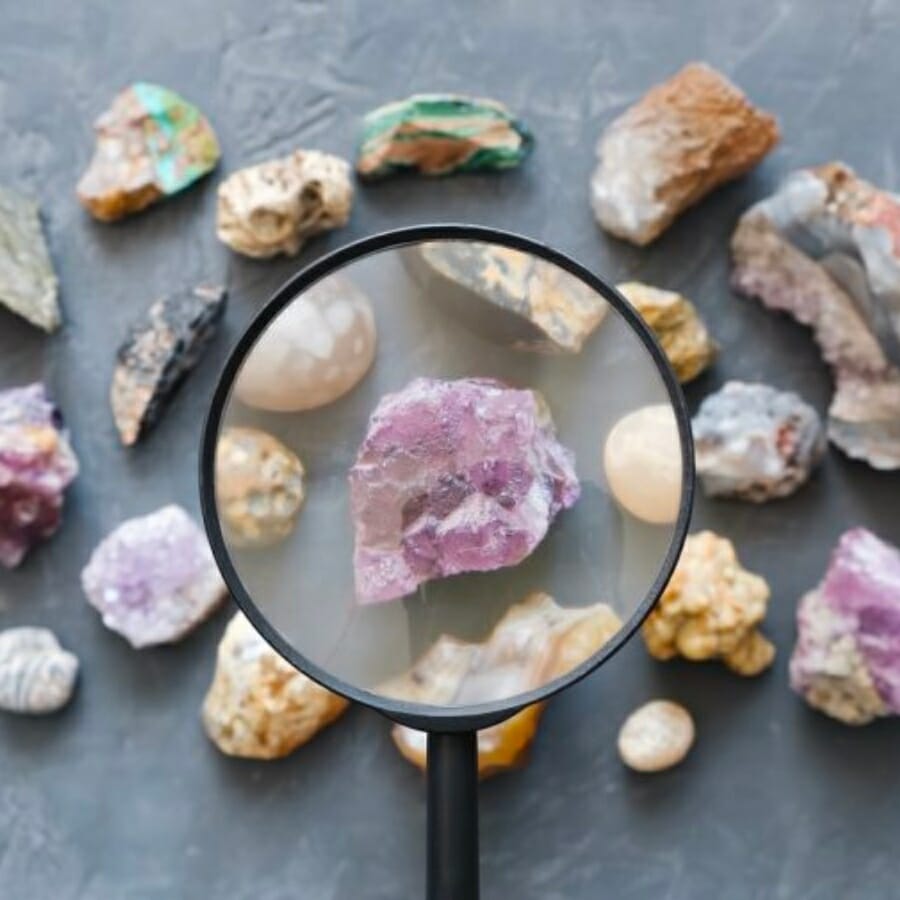
Look at the color, texture, and any visible features, like crystals or layers, of your rock or mineral. Take note of its overall appearance and compare it to reference materials or online resources that showcase various rocks and minerals as well. This can help you narrow down the possibilities.
Do a simple hardness test

How will you do a simple hardness test? Try to scratch the rock or mineral with common objects, like your fingernail, a copper penny, a steel knife, or a piece of glass.
If your rock or mineral gets scratched, it indicates a lower hardness than the testing material. By comparing the scratch results to a hardness scale, such as the Mohs Scale of Hardness, you can estimate the relative hardness of your specimen.
Try a streak test
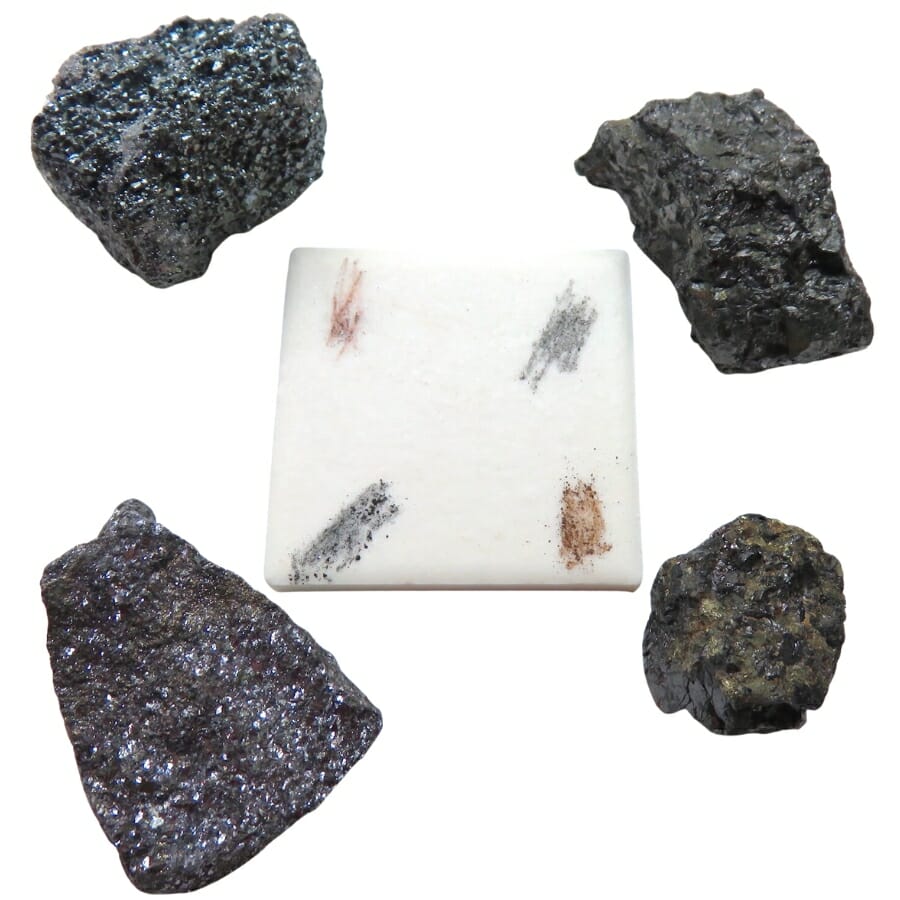
A streak test involves rubbing your rock or mineral against an unglazed porcelain tile or a piece of unglazed ceramic. The resulting color of the streak left behind can be compared to reference materials. For example, minerals like Hematite have a characteristic reddish-brown streak, while Graphite leaves a black streak.
Test how it reacts to acids

Some minerals react with acids in distinct ways. You can place a small drop of diluted acid, like vinegar or hydrochloric acid, on a discreet part of the rock or mineral and observe if it fizzes, bubbles, or reacts in any way. This can help identify minerals such as Calcite or Dolomite, which effervesce in the presence of acid.
Just a reminder: Take caution when handling acids and use appropriate safety measures.
Check if it’s magnetic

You can use a small magnet and see if it’s attracted to the rock or mineral. Magnetic minerals, such as Magnetite, will exhibit magnetic properties and be drawn towards the magnet. This test can also provide clues about the presence of certain minerals in your specimen.

